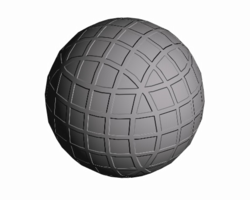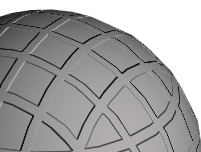TAPESTRY: The Art of Representation and Abstraction
Bump Maps
What's it all about?
Visually, a bump (or a dent) is a just bit of surface that's got a slightly different orienetation in space than it's neighboring surface. One way to do that is to actually model a bulge in the geometry of the surface, but this will require a bunch of polygons for each bump, slowing down all related operations. We need a way to cheat.

The bump-map trick
Bump maps take advantage of two things: (1) Bumps are minor surface variations, and (2) Smoothing and (color) texture-map processing works on pixels one at a time. Basically, a bump map specifies a small variation in the intensity calculation, producing the illusion that the surface has a bump. This is done with an image, usually gray-scale, that uses color to specify the variation.

The only difference between the two spheres shown here is that the first one (above) includes a grid bump map as part of the texture map, while the second one (left) is just a smoothed sphere.

Spotting the maps
In most applications, bump maps work really well and are hard to spot. One way in which you might spot a bump map, however, is by examining the "horizons" of an object, where the "bumps" (remember, they're not part of the geometry) should stick out from the object--they won't be there (see image at right).
Last updated: April, 2014
